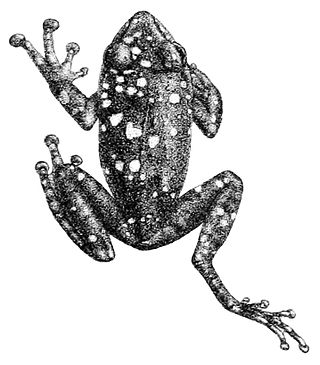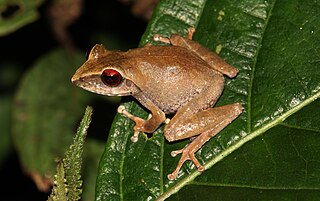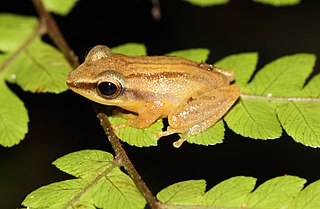
Pseudophilautus adspersus is an extinct species of frog in the family Rhacophoridae. It was endemic to Sri Lanka.

Pseudophilautus alto is a species of frogs in the family Rhacophoridae. It is endemic to the Central Highlands of Sri Lanka and known from the Horton Plains and Pattipola.

Pseudophilautus auratus, commonly called golden shrub frog, is a species of frog in the family Rhacophoridae, endemic to Sri Lanka.
Pseudophilautus dimbullae is an extinct species of frog in the family Rhacophoridae. It was endemic to Sri Lanka. It is only known from the holotype collected in 1933.
Pseudophilautus eximius is an extinct species of frog in the family Rhacophoridae. It was endemic to Sri Lanka. It is only known from the holotype collected in 1933.
Pseudophilautus extirpo, known as blunt-snouted shrub frog, is an extinct species of frog in the family Rhacophoridae. It was endemic to Sri Lanka. It is only known from the holotype collected in 1882. The specific name extirpo is Latin meaning "destroy" or "eradicate" and refers to the apparent extinction of this species.
Pseudophilautus halyi, known as pattipola shrub frog, is an extinct species of frog in the family Rhacophoridae. It was endemic to Sri Lanka. It is only known from the holotype collected in 1899. The specific name halyi honours Amyrald Haly, the first director of the Ceylon Museum, author of the "Natural History of Ceylon", and the collector of the holotype.

Pseudophilautus hoipolloi, known as anthropogenic shrub frog, is a species of frogs in the family Rhacophoridae.
Pseudophilautus leucorhinus, also known as white-nosed shrub frog, pointed-nosed shrub frog, whitenose bubble-nest frog, and Marten's bush frog, was a species of frog in the family Rhacophoridae. It was endemic to Sri Lanka. It is only known from the holotype that was collected some time before 1856 from the indefinite type locality "Ceylon". Pseudophilautus wynaadensis from southwestern India has been considered conspecific with this species, but these species are now considered distinct.
Pseudophilautus limbus, also known as Haycock shrub frog, is a species of frogs in the family Rhacophoridae. It is endemic to southwestern Sri Lanka, including its type locality, Haycock Hill (Hiniduma) Forest Reserve. The specific name limbus, from the Latin for "edge" or "border", refers to the species originally having been known only from the border of the Haycock Hill Forest Reserve.

Pseudophilautus schmarda is a species of frog in the family Rhacophoridae. It is endemic to the central hills of Sri Lanka and is known from the Peak Wilderness Sanctuary, Agra Bopath, Horton Plains, and Pedro. The specific name schmarda honours Ludwig Karl Schmarda, an Austrian physician, naturalist, and traveler. Common names Sri Lanka bug-eyed frog and Schmarda's shrub frog have been coined for it.

Pseudophilautus sordidus, commonly known as the grubby shrub frog is a species of frog in the family Rhacophoridae.

Pseudophilautus variabilis, also known as the variable bush frog or variable bubble-nest frog, is a species of frog in the family Rhacophoridae. This now extinct species was endemic to Sri Lanka. Despite extensive searches in recent times, it is only known from collections prior to 1858. The reasons for its disappearance are unknown but probably involve habitat loss.

Pseudophilautus viridis, or the dull-green shrub frog, is a species of frogs in the family Rhacophoridae. It is endemic to Sri Lanka and occurs in the central hills of south-central Sri Lanka.
Pseudophilautus zal, commonly known as the white blotched shrub frog, is an extinct species of frog in the family Rhacophoridae. It was endemic to Sri Lanka. It is only known from the type series consisting of three old museum specimens.
Pseudophilautus pardus is an extinct species of Sri Lankan shrub frogs in the family Rhacophoridae. Despite extensive surveys in recent years, the species is known only from a collection made prior to 1858. The reason for its extinction is unknown but probably relates loss of forests.

Pseudophilautus is a genus of shrub frogs in the family Rhacophoridae endemic to the Western Ghats of southwestern India and to Sri Lanka where the majority of the species are found. Many of them are already extinct. On the other, some species believed to be extinct have also been rediscovered.
Pseudophilautus simba is a species of frogs in the family Rhacophoridae endemic to Sri Lanka. It is only known from its type locality in the Morningside Forest Reserve, adjacent to the Sinharaja Forest Reserve, near Rakwana, southern Sri Lanka.
Pseudophilautus singu is a species of frog in the family Rhacophoridae, endemic to southwestern Sri Lanka. It is known from the Kanneliya-Dediyagala-Nakiyadeniya, Kitulgala, and Kottawa Forest Reserves and from the Sinharaja World Heritage Site. The specific name singu is Sinhalese for "horn" and refers to the horn-like tubercles on the upper eyelids of this frog. Common name Sri Lanka short-horned shrub frog has been coined for it.

Sri Lanka petite shrub frog,, is a species of frogs in the family Rhacophoridae, endemic to southwestern Sri Lanka. This relatively recently described species is only known from two locations in the Galle District, Beraliya and Kanneliya Forest Reserves. The specific name tanu is Sinhalese for "slender" and refers to the habitus of this frog.













